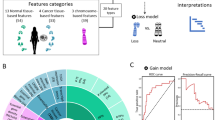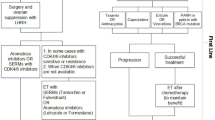Abstract
Background Metaplastic breast carcinomas (MBCs) comprise a group of aggressive and chemotherapy resistant cancers characterised by neoplastic cells displaying differentiation towards squamous epithelium or mesenchymal elements. Previous histopathological and immunohistochemical analysis of MBCs suggested that these cancers would have a basal-like profile. Methods We investigated the molecular subtype of 20 MBCs using microarray-based expression profiling data. These data were compared with those of 79 invasive ductal carcinomas (IDCs) of basal-like phenotype by unsupervised hierarchical clustering, supervised analysis and pathway analysis. Results We demonstrate that 95% of all MBCs are of basal-like molecular subtype. Furthermore, unsupervised hierarchical clustering analysis and pathway analysis of the profiles of MBCs revealed that MBCs are part of the spectrum of basal-like breast cancers. Significance analysis of microarrays (SAM) identified 1,385 transcripts differentially expressed between MBCs and IDCs of basal-like phenotype. Pathway analysis using these genes revealed that DNA repair pathways, including BRCA1 pathway, PTEN, a gene whose loss of function is associated with resistance to chemotherapy, and TOP2A, the molecular target of anthracyclines, are significantly downregulated in MBCs compared to basal-like IDCs. These findings may at least in part explain the reported poor responses to chemotherapy of MBCs. Furthermore, MBCs showed significantly higher expression of genes related to myoepithelial differentiation and epithelial to mesenchymal transition (EMT). Conclusions Our results demonstrate that MBCs are part of the spectrum of basal-like breast carcinomas and display a myoepithelial and EMT-like molecular make-up. The reported poorer response to chemotherapeutic agents in patients with MBCs may stem from downregulated DNA damage response pathways, PTEN and TOP2A.



Similar content being viewed by others
References
Huvos AG, Lucas JC Jr, Foote FW Jr (1973) Metaplastic breast carcinoma. Rare form of mammary cancer. N Y State J Med 73:1078–1082
Wargotz ES, Deos PH, Norris HJ (1989) Metaplastic carcinomas of the breast. II. Spindle cell carcinoma. Hum Pathol 20:732–740. doi:10.1016/0046-8177(89)90065-8
Wargotz ES, Norris HJ (1989) Metaplastic carcinomas of the breast. III. Carcinosarcoma. Cancer 64:1490–1499
Wargotz ES, Norris HJ (1989) Metaplastic carcinomas of the breast. I. Matrix-producing carcinoma. Hum Pathol 20:628–635. doi:10.1016/0046-8177(89)90149-4
Wargotz ES, Norris HJ (1990) Metaplastic carcinomas of the breast. IV. Squamous cell carcinoma of ductal origin. Cancer 65:272–276. doi :10.1002/1097-0142(19900115)65:2<272::AID-CNCR2820650215>3.0.CO;2-6
Hennessy BT, Giordano S, Broglio K et al (2006) Biphasic metaplastic sarcomatoid carcinoma of the breast. Ann Oncol 17:605–613. doi:10.1093/annonc/mdl006
Hennessy BT, Krishnamurthy S, Giordano S et al (2005) Squamous cell carcinoma of the breast. J Clin Oncol 23:7827–7835. doi:10.1200/JCO.2004.00.9589
Leibl S, Moinfar F (2005) Metaplastic breast carcinomas are negative for Her-2 but frequently express EGFR (Her-1): potential relevance to adjuvant treatment with EGFR tyrosine kinase inhibitors? J Clin Pathol 58:700–704. doi:10.1136/jcp.2004.025163
Reis-Filho JS, Milanezi F, Carvalho S et al (2005) Metaplastic breast carcinomas exhibit EGFR, but not HER2, gene amplification and overexpression: immunohistochemical and chromogenic in situ hybridization analysis. Breast Cancer Res 7:R1028–R1035. doi:10.1186/bcr1341
Perou CM, Sorlie T, Eisen MB et al (2000) Molecular portraits of human breast tumours. Nature 406:747–752. doi:10.1038/35021093
Rakha EA, Reis-Filho JS, Ellis IO (2008) Basal-like breast cancer: a critical review. J Clin Oncol 26:2568–2581. doi:10.1200/JCO.2007.13.1748
Livasy CA, Karaca G, Nanda R et al (2006) Phenotypic evaluation of the basal-like subtype of invasive breast carcinoma. Mod Pathol 19:264–271. doi:10.1038/modpathol.3800528
Fulford LG, Easton DF, Reis-Filho JS et al (2006) Specific morphological features predictive for the basal phenotype in grade 3 invasive ductal carcinoma of breast. Histopathology 49:22–34. doi:10.1111/j.1365-2559.2006.02453.x
Turner NC, Reis-Filho JS, Russell AM et al (2007) BRCA1 dysfunction in sporadic basal-like breast cancer. Oncogene 26:2126–2132. doi:10.1038/sj.onc.1210014
Reis-Filho JS, Milanezi F, Steele D et al (2006) Metaplastic breast carcinomas are basal-like tumours. Histopathology 49:10–21. doi:10.1111/j.1365-2559.2006.02467.x
Savage K, Lambros MB, Robertson D et al (2007) Caveolin 1 is overexpressed and amplified in a subset of basal-like and metaplastic breast carcinomas: a morphologic, ultrastructural, immunohistochemical, and in situ hybridization analysis. Clin Cancer Res 13:90–101. doi:10.1158/1078-0432.CCR-06-1371
Leibl S, Gogg-Kammerer M, Sommersacher A et al (2005) Metaplastic breast carcinomas: are they of myoepithelial differentiation? Immunohistochemical profile of the sarcomatoid subtype using novel myoepithelial markers. Am J Surg Pathol 29:347–353. doi:10.1097/01.pas.0000152133.60278.d2
Reis-Filho JS, Milanezi F, Paredes J et al (2003) Novel and classic myoepithelial/stem cell markers in metaplastic carcinomas of the breast. Appl Immunohistochem Mol Morphol 11:1–8. doi:10.1097/00022744-200303000-00001
Sitterding SM, Wiseman WR, Schiller CL et al (2008) AlphaB-crystallin: a novel marker of invasive basal-like and metaplastic breast carcinomas. Ann Diagn Pathol 12:33–38. doi:10.1016/j.anndiagpath.2007.02.004
Gilbert JA, Goetz MP, Reynolds CA et al (2008) Molecular analysis of metaplastic breast carcinoma: high EGFR copy number via aneusomy. Mol Cancer Ther 7:944–951. doi:10.1158/1535-7163.MCT-07-0570
Reis-Filho JS, Pinheiro C, Lambros MB et al (2006) EGFR amplification and lack of activating mutations in metaplastic breast carcinomas. J Pathol 209:445–453. doi:10.1002/path.2004
Weigelt B, Horlings HM, Kreike B et al (2008) Refinement of breast cancer classification by molecular characterisation of histological special types. J Pathol 216:141–150. doi:10.1002/path.2407
Jacquemier J, Padovani L, Rabayrol L et al (2005) Typical medullary breast carcinomas have a basal/myoepithelial phenotype. J Pathol 207:260–268. doi:10.1002/path.1845
Azoulay S, Lae M, Freneaux P et al (2005) KIT is highly expressed in adenoid cystic carcinoma of the breast, a basal-like carcinoma associated with a favorable outcome. Mod Pathol 18:1623–1631
Vincent-Salomon A, Gruel N, Lucchesi C et al (2007) Identification of typical medullary breast carcinoma as a genomic sub-group of basal-like carcinomas, a heterogeneous new molecular entity. Breast Cancer Res 9:R24. doi:10.1186/bcr1666
Turner NC, Reis-Filho JS (2006) Basal-like breast cancer and the BRCA1 phenotype. Oncogene 25:5846–5853. doi:10.1038/sj.onc.1209876
Lien HC, Lin CW, Mao TL et al (2004) p53 overexpression and mutation in metaplastic carcinoma of the breast: genetic evidence for a monoclonal origin of both the carcinomatous and the heterogeneous sarcomatous components. J Pathol 204:131–139. doi:10.1002/path.1624
McCarthy A, Savage K, Gabriel A et al (2007) A mouse model of basal-like breast carcinoma with metaplastic elements. J Pathol 211:389–398. doi:10.1002/path.2124
Liu X, Holstege H, van der Gulden H et al (2007) Somatic loss of BRCA1 and p53 in mice induces mammary tumors with features of human BRCA1-mutated basal-like breast cancer. Proc Natl Acad Sci USA 104:12111–12116. doi:10.1073/pnas.0702969104
Sarrio D, Rodriguez-Pinilla SM, Hardisson D et al (2008) Epithelial-mesenchymal transition in breast cancer relates to the basal-like phenotype. Cancer Res 68:989–997. doi:10.1158/0008-5472.CAN-07-2017
Kim MJ, Ro JY, Ahn SH et al (2006) Clinicopathologic significance of the basal-like subtype of breast cancer: a comparison with hormone receptor and Her2/neu-overexpressing phenotypes. Hum Pathol 37:1217–1226. doi:10.1016/j.humpath.2006.04.015
Kreike B, van Kouwenhove M, Horlings H et al (2007) Gene expression profiling and histopathological characterization of triple-negative/basal-like breast carcinomas. Breast Cancer Res 9:R65. doi:10.1186/bcr1771
Hu Z, Fan C, Oh DS et al (2006) The molecular portraits of breast tumors are conserved across microarray platforms. BMC Genomics 7:96. doi:10.1186/1471-2164-7-96
Eisen M, Spellman P, Brown P et al (1998) Cluster analysis and display of genome-wide expression patterns. Proc Natl Acad Sci USA 95:14863–14868. doi:10.1073/pnas.95.25.14863
Tusher VG, Tibshirani R, Chu G (2001) Significance analysis of microarrays applied to the ionizing radiation response. Proc Natl Acad Sci USA 98:5116–5121. doi:10.1073/pnas.091062498
Nielsen TO, Hsu FD, Jensen K et al (2004) Immunohistochemical and clinical characterization of the basal-like subtype of invasive breast carcinoma. Clin Cancer Res 10:5367–5374. doi:10.1158/1078-0432.CCR-04-0220
Rouzier R, Perou CM, Symmans WF et al (2005) Breast cancer molecular subtypes respond differently to preoperative chemotherapy. Clin Cancer Res 11:5678–5685. doi:10.1158/1078-0432.CCR-04-2421
Reis-Filho JS, Simpson PT, Turner NC et al (2006) FGFR1 emerges as a potential therapeutic target for lobular breast carcinomas. Clin Cancer Res 12:6652–6662. doi:10.1158/1078-0432.CCR-06-1164
Ashworth A (2008) A synthetic lethal therapeutic approach: poly (ADP) ribose polymerase inhibitors for the treatment of cancers deficient in DNA double-strand break repair. J Clin Oncol 26:3785–3790. doi:10.1200/JCO.2008.16.0812
Hamperl H (1970) The myothelia (myoepithelial cells). Normal state; regressive changes; hyperplasia; tumors. Curr Top Pathol 53:161–220
Al-Hajj M, Wicha MS, Benito-Hernandez A et al (2003) Prospective identification of tumorigenic breast cancer cells. Proc Natl Acad Sci USA 100:3983–3988. doi:10.1073/pnas.0530291100
Ginestier C, Hur MH, Charafe-Jauffret E et al (2007) ALDH1 is a marker of normal and malignant human mammary stem cells and a predictor of poor clinical outcome. Cell Stem Cell 1:555–567. doi:10.1016/j.stem.2007.08.014
Liu S, Dontu G, Mantle ID et al (2006) Hedgehog signaling and Bmi-1 regulate self-renewal of normal and malignant human mammary stem cells. Cancer Res 66:6063–6071. doi:10.1158/0008-5472.CAN-06-0054
Yu J, Yu J, Rhodes DR et al (2007) A polycomb repression signature in metastatic prostate cancer predicts cancer outcome. Cancer Res 67:10657–10663. doi:10.1158/0008-5472.CAN-07-2498
Jones C, Mackay A, Grigoriadis A et al (2004) Expression profiling of purified normal human luminal and myoepithelial breast cells: identification of novel prognostic markers for breast cancer. Cancer Res 64:3037–3045. doi:10.1158/0008-5472.CAN-03-2028
Kovacs A, Walker RA (2003) P-cadherin as a marker in the differential diagnosis of breast lesions. J Clin Pathol 56:139–141. doi:10.1136/jcp.56.2.139
Koker MM, Kleer CG (2004) p63 expression in breast cancer: a highly sensitive and specific marker of metaplastic carcinoma. Am J Surg Pathol 28:1506–1512. doi:10.1097/01.pas.0000138183.97366.fd
Lien HC, Hsiao YH, Lin YS et al (2007) Molecular signatures of metaplastic carcinoma of the breast by large-scale transcriptional profiling: identification of genes potentially related to epithelial-mesenchymal transition. Oncogene 26:7859–7871. doi:10.1038/sj.onc.1210593
Petersen OW, Lind Nielsen H, Gudjonsson T et al (2001) The plasticity of human breast carcinoma cells is more than epithelial to mesenchymal conversion. Breast Cancer Res 3:213–217. doi:10.1186/bcr298
Elston CW, Ellis IO (1991) Pathological prognostic factors in breast cancer. I. The value of histological grade in breast cancer: experience from a large study with long-term follow-up. Histopathology 19:403–410. doi:10.1111/j.1365-2559.1991.tb00229.x
Wolff AC, Hammond ME, Schwartz JN et al (2007) American Society of Clinical Oncology/College of American Pathologists guideline recommendations for human epidermal growth factor receptor 2 testing in breast cancer. J Clin Oncol 25:118–145. doi:10.1200/JCO.2006.09.2775
Acknowledgements
B. Weigelt is supported by a postdoctoral fellowship from the Dutch Cancer Society (KWF). J. Reis-Filho is fully supported by Breakthrough Breast Cancer.
Author information
Authors and Affiliations
Corresponding authors
Electronic supplementary material
Below is the link to the electronic supplementary material.
Rights and permissions
About this article
Cite this article
Weigelt, B., Kreike, B. & Reis-Filho, J.S. Metaplastic breast carcinomas are basal-like breast cancers: a genomic profiling analysis. Breast Cancer Res Treat 117, 273–280 (2009). https://doi.org/10.1007/s10549-008-0197-9
Received:
Accepted:
Published:
Issue Date:
DOI: https://doi.org/10.1007/s10549-008-0197-9




